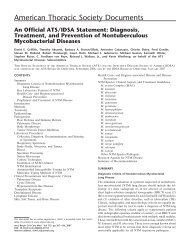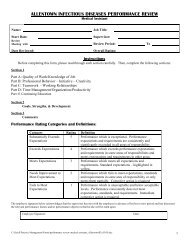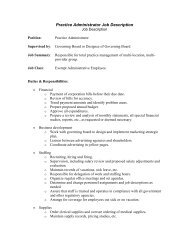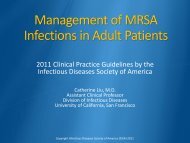bad bugs, need drugs - Infectious Diseases Society of America
bad bugs, need drugs - Infectious Diseases Society of America
bad bugs, need drugs - Infectious Diseases Society of America
You also want an ePaper? Increase the reach of your titles
YUMPU automatically turns print PDFs into web optimized ePapers that Google loves.
BAD BUGS, NEED DRUGS<br />
The 10 x ‘20 initiative<br />
Robert J. Guidos, JD<br />
VP, Public Policy &<br />
Government Relations<br />
<strong>Infectious</strong> <strong>Diseases</strong><br />
<strong>Society</strong> <strong>of</strong> <strong>America</strong><br />
FIS Conference; Manchester, United Kingdom,<br />
November 18, 2011
Primary Pr<strong>of</strong>essional Activity<br />
2%<br />
4% 5%<br />
7%<br />
54%<br />
8% 3%<br />
14%<br />
3%<br />
Administration<br />
Basic Research<br />
Clinical Microbiology<br />
Clinical Research<br />
Hospital Epidemiology<br />
Patient Care<br />
Public Hlth<br />
Teaching/Education<br />
Other
U<br />
S<br />
A<br />
p<br />
p<br />
r<br />
o<br />
v<br />
a<br />
l<br />
s<br />
16<br />
14<br />
12<br />
10<br />
8<br />
6<br />
4<br />
2<br />
0<br />
1983-<br />
1987<br />
1988-<br />
1992<br />
1993-<br />
1997<br />
1998-<br />
2002<br />
2003-<br />
2007<br />
2008-<br />
2011<br />
Spellberg, CID 2004, Modified
www.antibioticaction.com
IDSA‘s 2004<br />
Report:<br />
―Bad Bugs, No<br />
Drugs: As<br />
Antibiotic<br />
Discovery<br />
Stagnates, A<br />
Public Health<br />
Crisis Brews‖
Our patients <strong>need</strong> new antibiotics to stay<br />
alive!<br />
• Unlike other disease areas (cancer, HIV/AIDS, etc.), there<br />
are no easily identifiable patient advocacy groups to put<br />
a push for change and to put a human face on the drug<br />
resistance problem<br />
• IDSA decided it must step in to advocate on our patients‟<br />
behalf<br />
• We have not taken any pharmaceutical funding to support<br />
these advocacy efforts
On-going information sharing<br />
efforts with:<br />
• Senior pharmaceutical, biotechnology,<br />
and diagnostic company executives,<br />
anti-infective division heads,<br />
government relations and public<br />
policy staff<br />
• Venture capitalists
MARKET FAILURE<br />
• Economic/Return on Investment<br />
• Regulatory uncertainty—FDA<br />
plus<br />
• Scientific challenges
PEW, IDSA, PhRMA Meeting
• Antibiotics used for short duration<br />
• Science is difficult (e.g., gram negative cell wall)<br />
• Insufficient research support<br />
• Lack <strong>of</strong> sufficient diagnostic tools<br />
• Antimicrobial stewardship is essential, but<br />
affects pr<strong>of</strong>itability<br />
• Pricing: generic competition is cheap<br />
• Drugs in other markets (chronic disease,<br />
lifestyle) are more attractive
Additional Reports:<br />
• “Bad Bugs, No Drugs; No ESKAPE”; IDSA‟s latest update on the<br />
antibiotic drug pipeline; Boucher et al, CID, January 1, 2009<br />
• “The Epidemic <strong>of</strong> Antimicrobial Resistant Infections: A Call to<br />
Action to the Medical Community”, Spellberg et al, CID Jan.<br />
2008<br />
• Numerous position papers focused on FDA clinical trial designs<br />
(CAP; cSSSI; HAP/VAP, superiority for MDR organisms)<br />
• The 10 x „20 Initiative, Global Commitment, April 15, 2010<br />
• Combating Antimicrobial Resistance: Policy Recommendations<br />
to Save Lives, Spellberg, Guidos et al, CID supp., May 2011
World Health Day 2011<br />
IDSA Policy Paper “Combating Antimicrobial Resistance:<br />
Policy Recommendations to Save Lives” (CID) May 2011
2009 analyses by IDSA & European Centre for<br />
Disease Prevention and Control (ECDC)/European<br />
Medicines Agency (EMA)<br />
• Only 15-16 antibiotics are in development<br />
• Only 8 have activity against key Gram-negative<br />
bacteria; these cause the most life-threatening<br />
infections<br />
• Of these, NONE have activity against bacteria<br />
resistant to all currently available <strong>drugs</strong><br />
Boucher et al. Clinical <strong>Infectious</strong> <strong>Diseases</strong> 2009; 48:1–12
Two Years Later….2011 IDSA Update<br />
• 10 compounds active vs. resistant Gram-negative<br />
bacteria in clinical development as intravenous (IV)<br />
therapy<br />
• It is still the case that NONE have activity against<br />
bacteria resistant to all currently available <strong>drugs</strong><br />
• No ongoing studies for the most life-threatening<br />
Gram-negative infections (hospital-associated<br />
pneumonia, aka HABP/VABP), an infection where<br />
> 20% <strong>of</strong> patients die
Many Disincentives to Antibiotic R&D<br />
Therapy<br />
Area<br />
NPV*<br />
Development<br />
($$)<br />
Development<br />
(years)<br />
Price Use Patient pop<br />
$1150m $$$$ Chronic Large<br />
Neurology $720m $$$$ Chronic Large<br />
Oncology $300m $$$ Acute/<br />
Chronic<br />
Medium<br />
Musculoskeletal<br />
Antibacterials<br />
$100m $$$ Acute Small (specialist<br />
hospital<br />
antibiotics)<br />
David Payne, GSK, September 2011 IDSA/Pew/PhRMA conference<br />
*Projan 2003<br />
16
*Antibiotics:<br />
#<br />
Other<br />
areas:<br />
DISCOVERY<br />
72<br />
Leads<br />
15<br />
PRECLINICAL<br />
36<br />
Candidates<br />
12 9<br />
PHASE 1<br />
CLINICAL TRIALS<br />
PHASE 2<br />
PHASE 3<br />
18 6 3 2<br />
4.6 1.6 1.1<br />
FDA REVIEW<br />
ONE FDA<br />
APPROVED<br />
DRUG<br />
3-10 years<br />
6-7 years<br />
*Discovery to Phase 2 attrition based on real data for 12 novel mechanism antibiotic<br />
candidates at GSK<br />
*Hit to Phase 2 based on novel mechanism AB discovery (GSK) # Based on Paul, et al (2010), Nature Reviews Drug Discovery 9:<br />
203-214. David Payne , GSK, September 2011 IDSA/Pew/PhRMA Meeting
Bottom Line<br />
• We can‘t make companies develop new<br />
antibiotics<br />
• We have to make them want to develop new<br />
antibiotics
• Global Commitment to Develop 10 new systemic<br />
antibiotics by 2020 (CID; April 2010)<br />
• Bring together essential leaders: global political, scientific,<br />
industrial, economic, intellectual property, policy, medical<br />
and philanthropic leaders to determine the right<br />
combination <strong>of</strong> incentives necessary to establish a<br />
sustainable R&D enterprise
“High-Priority” Products<br />
• new systemic antibacterial <strong>drugs</strong> through the discovery<br />
<strong>of</strong> new drug classes as well as exploring possible new<br />
<strong>drugs</strong> from the existing classes <strong>of</strong> antibiotics (includes<br />
oral formulations)<br />
• products that treat serious/life-threatening infections<br />
that are resistant to current antibiotics (the “ESKAPE”<br />
pathogens, e.g., emerging gram-negative bacteria, S.<br />
aureus)
Current Status <strong>of</strong> the 10 x ‗20 Initiative
To Improve Antibiotic Return on Investment/<br />
Net Present Value (NPV)<br />
Need a variety <strong>of</strong> types <strong>of</strong> push and pull incentives—there is<br />
no single, rate-limiting step to overcome—although economic<br />
modeling shows that push incentives likely are more helpful<br />
Push: Decrease cost <strong>of</strong> development (e.g. tax credits, grants,<br />
contracts, milestone payments, public/private collaborations)<br />
Pull: Increase income linked to antibiotics (e.g. market<br />
exclusivity, patent extensions, prizes), but must not promote<br />
use/increased resistance<br />
Need to change societal/payor valuation <strong>of</strong> antibiotics—their<br />
true value is not recognized
IDSA‟s actions have prompted the U.S. Congress to<br />
consider solutions<br />
• Three antimicrobial resistance hearings held since April<br />
2010 (IDSA testified at 2)<br />
• We have succeeded in getting FDA and NIH leaders to<br />
publicly articulate the <strong>need</strong> for statutory incentives<br />
• Incentives legislation is moving forward Generating<br />
Antibiotic Incentives Now (GAIN) Act, introduced 2011<br />
(data exclusivity)<br />
• Discussions around including incentives provision on<br />
must-pass FDA legislation in 2012
• Most promising approaches may not be<br />
politically feasible due to lack <strong>of</strong> support for<br />
drug industry and costs<br />
• U.S. Congress is looking to cut health care<br />
and other costs—not to increase them<br />
• We are seeking the best achievable solutions<br />
in this difficult fiscal environment
A Clearly Defined and Viable Regulatory Approval<br />
Pathway<br />
• After a decade <strong>of</strong> collaborative work (FDA/IDSA/industry), no clear<br />
FDA pathway to antibiotic approval<br />
• Several FDA issued clinical trial guidances are not feasible<br />
• Industry sponsors are at a loss as to how to proceed<br />
• October 2011: IDSA urged the FDA Commissioner to ask the<br />
Institute <strong>of</strong> Medicine for its opinion on the agency‘s approaches<br />
• One positive note: In 2010, FDA contacted the Foundation for the<br />
NIH (FNIH)Biomarkers Consortium to assist<br />
•Independent collaboration with academia, industry, IDSA, others<br />
to address endpoints in antibacterial trials<br />
•Initial focus skin infections and pneumonia (<strong>of</strong>ten the first studies<br />
<strong>of</strong> a new drug)
Finding Answers to Tough Scientific Questions and a<br />
Commitment to Share the Risk through Funding<br />
• IDSA lobbies Congress, NIH, Biomedical Advanced<br />
Research and Development Authority (BARDA) to invest<br />
more resources<br />
• IDSA analysis <strong>of</strong> 2009 NIH/NIAID funding found that,<br />
because <strong>of</strong> investments in other serious medical problems,<br />
NIAID's total funding commitment for antibacterial resistance<br />
research < $100 million; support for antibacterial drug<br />
discovery research < $70 million<br />
• We have called for significant expansion <strong>of</strong> NIAID‘s<br />
commitment to a total <strong>of</strong> $500 million<br />
• We also want a central patient clinical specimen repository<br />
to support diagnostic development/validation
Recent NIAID Actions<br />
• Since 2007 NIAID has funded numerous studies related to optimizing antibiotics‟<br />
effectiveness<br />
• Oct 2011 awarded $150 million in grants to companies with promising<br />
antibiotics/antivirals<br />
• Expanding Clinical Trials Infrastructure<br />
Purpose<br />
• To do studies that industry can‟t, or are not willing, to perform<br />
• Built upon existing infrastructure (from AIDS Trials Networks, etc.)<br />
• Develop clinical trials leadership group<br />
Timeline<br />
• Earliest start date: December 2013 (FY 2014)<br />
Funding<br />
• Initially $15-20M USD (the cost <strong>of</strong> ONE typical early study in patients) – IDSA<br />
is lobbying for more funding
Biomedical Advanced Research and Development Authority<br />
(BARDA)<br />
• Newly created in 2006<br />
• Contracts for advanced R&D <strong>of</strong> Gram-negative active <strong>drugs</strong> awarded<br />
to:<br />
• Achaogen ACHN 490<br />
• $27M over the 1 st two years; up to $64.5M<br />
• GSK 2251052<br />
• $38.5M over the 1 st two years; up to $94M
What Else is Needed?<br />
Global Collaboration
The EU-US Summit set up a Transatlantic Task Force on Antimicrobial<br />
Resistance (TATFAR), November 2009<br />
CDC, FDA, NIH, ECDC, EMA, EFSA, EC (SANCO, RTD)<br />
1) Appropriate therapeutic use <strong>of</strong> antibacterial <strong>drugs</strong> in the medical and veterinary<br />
communities<br />
2) Prevention <strong>of</strong> health care - and community – associated infections<br />
3) Strategies to improve the pipeline <strong>of</strong> new antibacterial <strong>drugs</strong><br />
Anna Lonnroth Sjödén ICAAC, October 2011
The final TATFAR report issued on September 22 with 17<br />
recommendations for strengthened EU and US<br />
cooperation in human and veterinary medicines against<br />
AMR<br />
Harmonization <strong>of</strong> two clinical trials on <strong>of</strong>f-patent antibiotics<br />
(colistin) – one funded by NIH, the other by EU<br />
EU-US Workshop "Challenges and solutions in the<br />
development <strong>of</strong> new diagnostic tests to combat<br />
antimicrobial resistance" 28-29 September 2011, Brussels<br />
Anna Lonnroth Sjödén ICAAC, October 2011
• Plan to promote, in a staged approach, unprecedented collaborative<br />
antibiotic R&D efforts<br />
• Use existing Innovative Medicines Initiative (IMI) -- a public-private<br />
scheme jointly funded by industry and the Commission<br />
• To encourage "unprecedented open sharing <strong>of</strong> knowledge" between<br />
companies at the pre-competitive research stage<br />
• Use flexibility in the current pharmaceutical legislation to give rapid<br />
approval to new antibiotics and work with governments to make sure<br />
they enjoyed "adequate market and pricing conditions.”<br />
Communication from the Commission to the European Parliament and the<br />
Council; Action plan against the rising threats from Antimicrobial<br />
Resistance. November 17, 2011.
IDSA Plans to Continue to Leverage<br />
the EU‟s Efforts<br />
• As we too are currently seeking:<br />
• a designated lead US agency to explore public private<br />
collaborations focused on early antibiotic discovery<br />
• Appropriate value-based reimbursement for novel antibiotics<br />
• As well as:<br />
• Tax-related incentives
33 Medical Societies including:<br />
• <strong>America</strong>n Medical Association<br />
• <strong>America</strong>n Academy <strong>of</strong> Pediatrics<br />
• <strong>America</strong>n College <strong>of</strong> Physicians<br />
• <strong>America</strong>n College <strong>of</strong> Surgeons<br />
• <strong>America</strong>n <strong>Society</strong> for Microbiology<br />
And from the European Union:<br />
• British <strong>Society</strong> <strong>of</strong> Antimicrobial Chemotherapy<br />
• British Infection <strong>Society</strong> & Association <strong>of</strong> Medical Microbiologists<br />
• European <strong>Society</strong> <strong>of</strong> Clinical Microbiology and <strong>Infectious</strong> <strong>Diseases</strong><br />
• International <strong>Society</strong> <strong>of</strong> Chemotherapy<br />
WE WANT YOUR ENDORSEMENT TOO!
Prior generations gave us the gift <strong>of</strong> antibiotics.<br />
Today, we have a moral obligation to ensure this global treasure is<br />
available for our children and future generations.<br />
rguidos@idsociety.org










